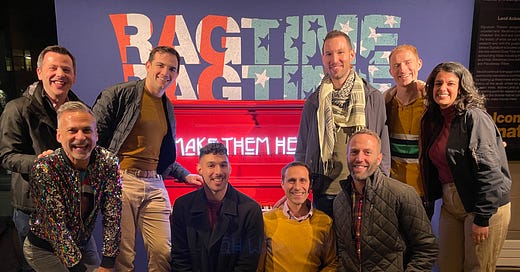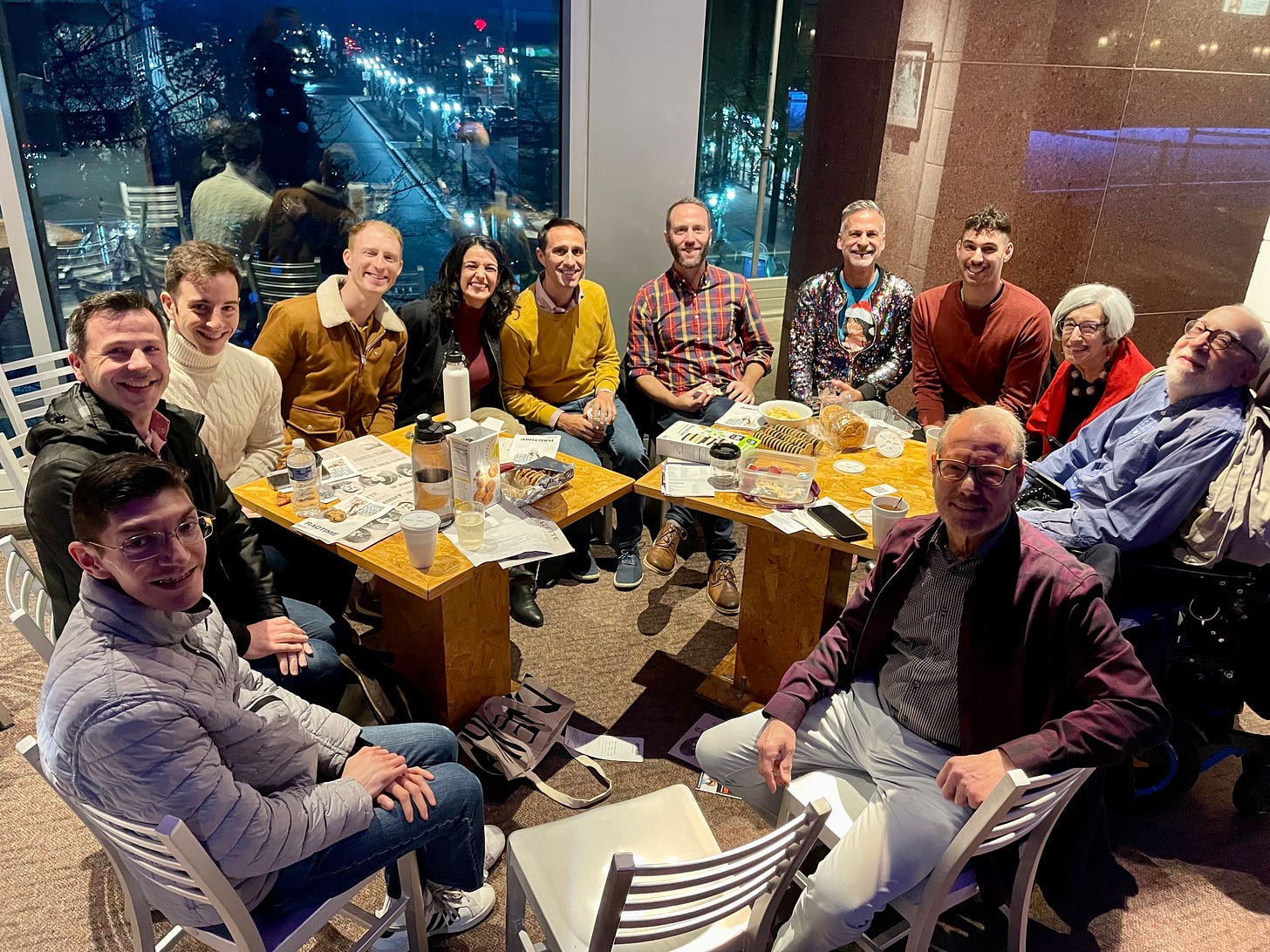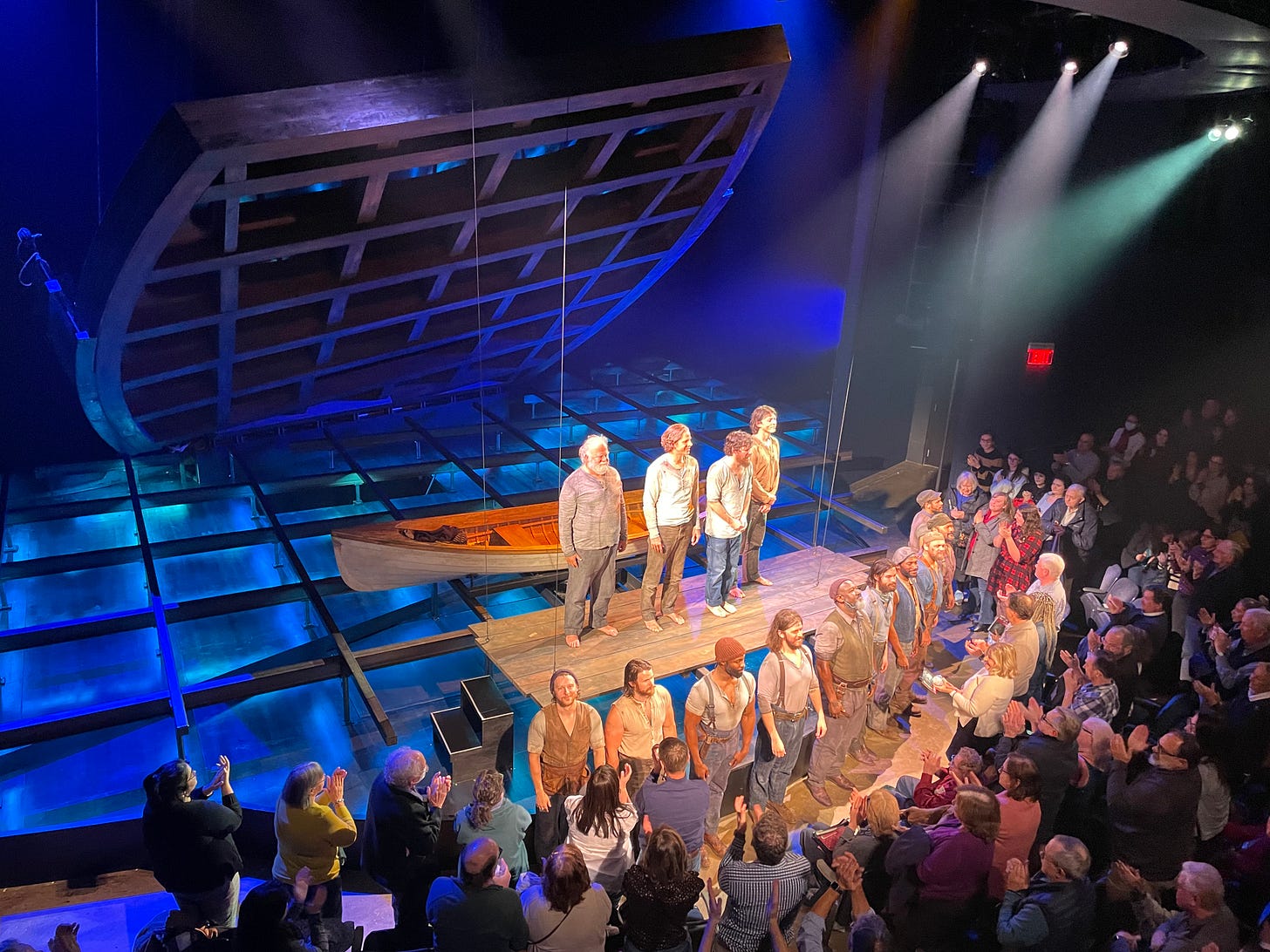19 subscribers journeyed to see "Ragtime" together!
Plus reviews of "Swept Away" and "Ragtime", playing here in DC.
Hello, play-goers! I’m happy to share something truly special with you—my newsletter’s second group trip to the theater! I’ve also got reviews of two extraordinary productions playing here in Washington.
“Ragtime” Group Trip
Nineteen of your fellow subscribers recently attended the musical “Ragtime” together at Signature Theatre in Arlington, VA. It was a thrill for me to share this experience with so many other theatre enthusiasts— and it gave me lots of shoulders to cry on during the wrenching, powerful show (review below). We gathered in the lobby afterwards to debrief what we had just seen over drinks and cookies. I facilitated a wide-ranging discussion, touching on the characters’ choices and whether the show is ultimately hopeful or pessimistic about the promise of America. This dialogue helped uncover more layers of this multi-faceted show. I will definitely do another group trip soon—stay tuned!
Review: Ragtime
In this must-see production of “Ragtime," the music is central to the storytelling, and the cast and orchestra rose to the occasion: a score has never sounded so good in Signature Theatre’s 277-seat black box space! Set at the turn of the 20th Century, the music is inspired by the major musical style of the period—ragtime—which becomes a metaphor for the many other changes happening at the time: African Americans coming up north and striving for better lives; Jewish immigrants arriving with sky-high hopes; great leaps in technology and manufacturing, like Henry Ford’s Model T; and more.

Through polyphonic storytelling—20 named characters, most of which are given at least some backstory and depth—the show addresses America’s promise and problems with complexity and nuance. A Jewish immigrant struggles in the Lower East side tenements; a rich white family evolves to love a Black one; and a Black man shifts from hope to despair as his dreams are dashed. Set at a time of great patriotism and optimism about the future of America, the show intertwines these stories. The central conflict emerges gradually and concerns a hate crime perpetrated against the Black musician, Coalhouse Walker, and his response. Even as the show delves deep into this storyline, it still keeps up with all the other characters, who have equally compelling arcs.
The source material, E.L. Doctorow’s 1975 novel, ties together these imaginary characters with real-life celebrities of the era, like Henry Ford, J.P. Morgan, Emma Goldman, and Booker T. Washington. This gives the proceedings even more import. In adapting the book for the stage, the three main collaborators—Stephan Flaherty (music), Lynne Ahrens (lyrics), and Terrence McNally (book)—expertly intertwine dialogue, underscoring, and songs together to tell many stories all at once. My group had very few areas of confusion—remarkable in a show with so many characters and storylines. Throughout, I kept admiring the sheer craft at hand: how streamlined it was, with no fluff, keeping up the dramatic tension even as it shifts focus among the characters.
This production manages to keep the grandness of the material even in a much smaller space. A 16-piece (!) orchestra brings the perfect score to vivid life, and a cast of 33 make every scene feel just as big as it’s supposed to, while giving voice to rich harmonies and moving melodies. Several of the principals are extraordinary actors and singers, especially Awa Sal Secka’s Sarah and Teal Wicks’s Mother. Lee Savage’s simple set design of cast-iron balcony, two spiral stairwells, and large factory-style windows evoke the era. Director Matthew Gardiner uses every inch of the stage to tell the story. A few choices stuck out: J.P. Morgan never set foot on the main level, he only presided from the upper level, accentuating the class division that is a theme of the show. Actors frequently stood in the shadows under the balcony level, bearing witness and ready to emerge to lend their voices in harmony. In a black box theater without traditional “wings,” this choice helped keep the focus on the storytelling and not actors’ entrances and exits.
The movement choreography was terrific. In a great sequence in which the characters all go to Atlantic City to escape the stress of the central conflict in New York City, actors held a string with a ballon at the end as they danced. That may sound straightforward, but the way it was blocked elevated it—multiple people in my group commented on this simple yet intriguing choice. In another scene set in the bleachers at a baseball game, the actors never stood up from their seats, yet Choreographer Ashleigh King still found ways for them to bounce and move with the upbeat ditty.
The powerful material, excellent performances, and solid direction and choreography brought the stories of Ragtime to vivid life, allowing me to consider the many political and social issues raised by the show. Is America a land of opportunity for immigrants? What role does celebrity play in our self-concept as a nation? What tactics are righteous in fighting against racism and police brutality? What is the appropriate role of a white ally in that struggle? These are fully realized flesh-and-blood characters, but their stories draw out big ideas. This is my favorite type of musical—one that forces you to really think through empathic storytelling that engages fully with complexity. This is likely to be the most intimate and well-done production of this near-perfect show we’ll get the chance to see—don't miss it!
Playing through January 7 at Signature Theatre.
Review: Swept Away
What would you do if you were stuck on a lifeboat with no help in sight? How far would you go to survive? Over 90 taut minutes, “Swept Away,” playing at Arena Stage, puts these questions to us in a captivating musical.
This one is truly different. The music is folk, from the catalogue of The Avett Brothers, richly orchestrated by Brian Usifer and Chris Miller. The cast is all male— rough, sea-faring men, dressed in suspenders and dirty shirts by costume designer Susan Hilferty. And most of the action takes place in a small lifeboat—a directing challenge that Michael Mayer surmounts with grace. It’s a small show in the sense of focusing narrowly on a few men, their values, their choices, their regrets—and the their possible redemption.
The book, by John Logan, employs dialogue that sits well in the mouths of 19th century rough-and-tumble sailors, yet is also reminiscent of a well-crafted parable, elevating the proceedings to myth or epic. I wasn’t familiar with The Avett Brothers before this production, but their music is beautiful and works well dramatically, lending the characters a means to express their yearning and depth of feeling.
The story is told from the perspective of the Mate, played with precision and gusto by the excellent John Gallagher, Jr. (“Spring Awakening”). It opens with him in a hospital, where his former shipmates taunt him to “tell the story” as a means of moving past it. The audience is cast as fellow patients in the hospital, listening to our compatriot tell his tale. And so begins another memory play, which I wrote about this summer (here). This framing is essential to the play’s success: we are in the Mate’s head, joining him on a journey of trying to make sense of a terrible past.
We follow him to a whaling boat, where we meet the other principals: a near-retirement Captain and two brothers, one who yearns for adventure and one who has chosen the steady path of maintaining his family’s farm; he just wants to get his younger brother home. An ensemble of sailors joins in as the boat sets sail. The first third of the play sets up the characters’ desires and relationships. An excellent dance sequence shows the contrast between Big Brother’s piety and the others’ pleasure-seeking. But it’s not until the shipwreck that the drama really sets in—an exhilarating stage transformation orchestrated by set designer Rachel Hauck. She achieves as jaw-dropping of an effect here as she does in “Hadestown’s” transition to the underworld, including a wind effect I’ve never experienced before.
With the principals stuck in a tiny boat for the balance of the one-act play, how do you keep it interesting? Again, Hauck delivers, with a simple yet powerful gesture: the boat turns, setting up a new perspective for each “scene.” A 180° change puts all the characters in new positions from the audience’s perspective, while still keeping them in that boat the whole time. Kevin Adams’s lighting design effectively shows the vast sea around them and guides us from day to night and back again as the characters drift. Mayer finds every possible arrangement of bodies in a small boat, keeping the story moving. I hardly took a breath as the gravity of the situation created incredible dramatic tension, which kept escalating as the time passed.
Stark Sands (“&Juliet”) gives Big Brother an earnest paternalism as he tenderly cares for his brother, played by the sweet-voiced Adrian Blake Enscoe. (Rounding out the foursome is Wayne Duvall, whose Captain is committed forever to the duties of the role.) With such a close focus, the acting here has to be impeccable, and these four performers rose to the challenge.
The contrast in movement vocabulary between the ensemble numbers at the beginning—big and bold stomping around on the deck, bustling around setting up ship—and the shipwreck section heightened the devastation. In this second part, David Neumann’s choreography managed to advance the story with subtle gestures, like two men raising an arm just-so in unison.
The play has commercial producers attached; this is its second stop after a run at Berkeley Rep and it reportedly has its sights on Brodway. Stay tuned to see if New York audiences will get the chance to be as “swept away” in this powerful story as I was!
Playing through January 14 at Arena Stage
Thanks for reading! Until soon, Mitch






